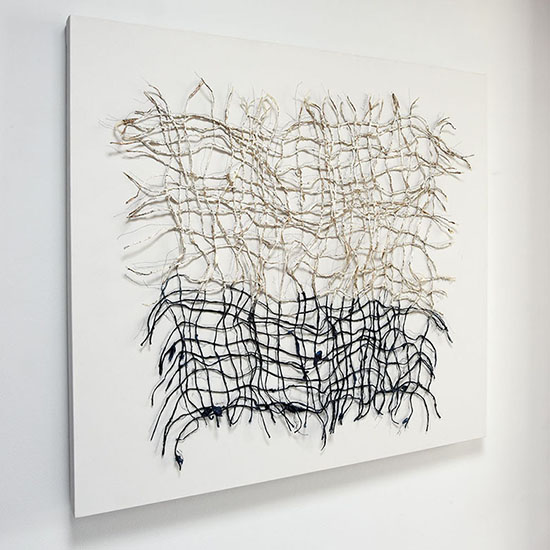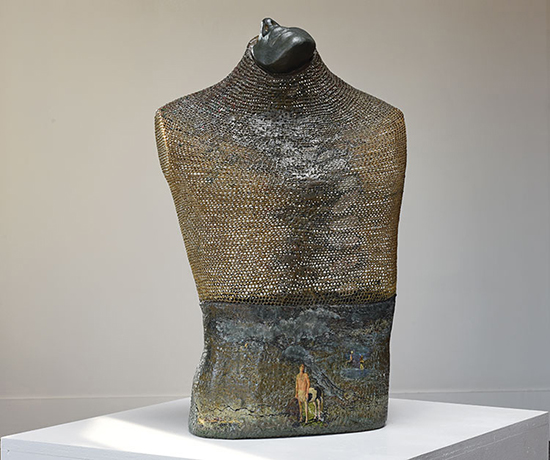
Southern Crossing Six by Kiyomi Iwata, Kibiso, silver leaf, indigo-color dye on canvas with pencil drawing, 30” x 33” x 1.75”, 2015
We started off August with Norma Minkowtiz’s Twister, a figure shaped sculpture made from fiber, paint, and resin. In works such as Twister Minkowitz explores her thoughts on the different paths people take in life. “Some of my themes explore making concessions, personal choices, different lifestyles, ways of survival and transitions in nature as well as human nature. I am engaged in creating works that weave the personal and universal together,” explains Minkowitz.
Next up we had Southern Crossing Six by Kiyomi Iwata. Iwata began her new series Southern Crossing Six after he recent move from New York to Richmond, Virginia. The move to the South felt as dramatic as her move from Japan to the United States many decades ago. While Iwata’s move from Japan to the United States was characterized by youthful anticipation and excitement, her move from New York to Richmond was much different. Iwata’s need for adventure was replaced by a desire of comfort of the familiar. The stark contrast between indigo dyed Kibiso silk and silver leaf juxtapose the two different landscapes…
Fossil, a bamboo sculpture by artist Jiro Yonezwa is a true masterpiece. Yonezawa, who studied in Beppu and apprenticed under Masakazu Ono, has been a bamboo basket maker and artists for over 35 years. For Yonezwa, it is the regenerative nature of bamboo which attracts him to the art form. While living in the United States from 1989 to 2007 his artwork became larger, bolder, and more sculptural. Yonezawa finds the process of preparing bamboo strips to weave, and the weaving the strips to be inherently meditative. While going through this process “the cacophony of life dissipates; the sculpture emerges vigorous and vibrant. Form, contrast, balance, and the interplay of space, color and texture” all come together.
Made with thousands of strands of 18-carat gold threads and Japanese silk thread, Grethe Wittrock’s Gold Reserves has a tactile sculptural presence. Like Wittrock’s Nordic Currents series, Gold Reserves also celebrates Danish Design and craftwork traditions. Unknown to many, the Danish national gold reserves were shipped to New York right before the start WWII to be stored in vaults at the Federal Reserve Bank to be kept safe from the Nazis.

Gold Reserves by Grethe Wittrock, custom-dyed Japanese silk yarns, konjaku root starched, various gold yarns, cotton yarn, 63” x 24”, 2008/09
“Although she attempts to retain a sense of the material in its raw state, she pushes it sculptural possibilities,” explains Milena Hoegsberg. Wittrock aims “to ‘respect’ the raw materials ‘energy’ by distilling it ‘to reveal its essence’.” Wittrock tediously chose the color combinations for each group of threads that were to be knotted, taking into consideration where the groups would lay against the brown threads and the texture they would create.


